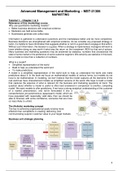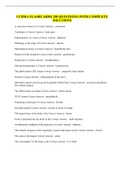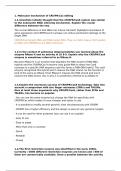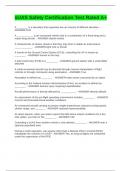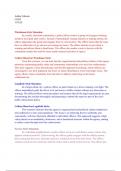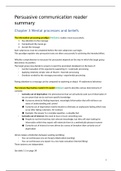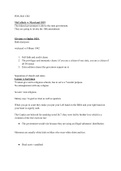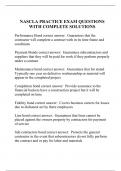MARKETING
Tutorial 1 – Chapter 1 & 3
Relevance of this (marketing) course
Why use quantitative marketing models?
• Better business decisions with empirical evidence
• Marketers are held accountable
• Businesses generate and collect data
Information is gathered to understand customers and the marketplace better and be more competitive.
Business decisions are strengthened with empirical evidence. As we consider any proposed strategy or
tactic, it is helpful to have information that suggests whether or not it’s a good idea to engage in that action.
Without such information, the decision is a guess. When a strategy is implemented, managers will want to
know whether doing so was worth it-what was the return on the investment (ROI) for that set of actions.
Many business and marketing questions may be answered by statistics, numbers that characterize the
state of some market or the preference of some customer segment. We certainly use statistics in this book,
but a model is more than a collection of numbers.
What is a model?
• Simplified representation of the world
• Build to help us understand the world and
• To make predictions
A model is a simplified representation of the world built to help us understand the world and make
predictions about it. In the book we focus on mathematical models of various forms, but models do not
have to be mathematical. In modeling, we don’t believe that the model captures all the elements of the
real world-we have characterized models as simplified versions of the world. We hope to build a model
that captures the essence of what is relevant for the business and marketing questions at hand. The
question about whether a model is useful is often best answered in comparison to another, competing
model. We want models to offer predictions. If we have a strong analytical understanding of the customer
of a market phenomenon, and we’ve formulated it into a
comprehensive yet parsimonious (spaarzaam) model, which we
have populated with reasonably valid data, then we should be
able to forecast, with some confidence, scenarios that are more
(or less) likely to unfold.
The (Holistic) marketing concept
The key to achieving organizational goals is being more
effective than competitors in creating, delivering, and
communicating superior customer value to your target markets.
Business unit strategic planning
1
,Strategic planning in the SBU: lower level in the organization, closer to the market/customers!
Process that if you later work as a marketing manager most work with (together with product planning)
1. Starts with the business mission: more or less given by higher level in the company → influences
strategy of SBU
2. SWOT analysis: strengths & weaknesses: think back to the elements of competitive advantage we
discussed at the beginning of the lecture
a. External environment: opportunities & threats: picture of the environment yesterday (macro and
micro environment)
b. Opportunity: development in the market (e.g. technology) that you can use to improve your
performance
c. Threat: development in the environment that will harm your position if you don’t do anything
d. Example: economic recession → turn threat into opportunity? Fuel prices are increasing → fuel
efficient cars, hybrid cars
3. Based on the SWOT: what should be our goals in the next planning period? Increase
profitability/market share?
4. Strategy formulation: how are you going to achieve your goals?
5. 5: Program formulation: How are you going to implement the strategy? Strategy: develop a new
product, Program: what are the activities you need for that?
6. Implementation: E.g., hire R&D people to develop the product
7. Feedback and control: Were you successful? Did you achieve your goals? If not, where did it go
wrong?
Link between business unit strategic planning and value delivery process:
• Choosing the value = strategy formulation
• Providing the value and communicating the value = program formulation
Assumed methodological knowledge
Research methodology
• Data collection, practical understanding of chance, principles of hypothesis testing, sample average
as an estimate for population average
Statistics
• Z-test, T-test, regression analysis, ANOVA, Factor Analysis
Learning outcomes (Marketing part)
• Analyse marketing plans for (new) products, brands and markets;
• Apply tools to guide marketing strategy;
- Apply cluster analysis for market segmentation,
- Apply factor analysis to measure marketing concepts
- Apply conjoint analyses for new product design, branding and pricing
• Evaluate marketing positioning of companies;
- Apply multidimensional scaling for positioning
• Evaluate the value of marketing models for marketing decision-making
Who are competitors?
• Not only direct competitors.
• Example beer breweries, competitors are: other beer breweries, coca cola and other soft drinks,
other alcoholic drinks, coffee, thee, movie theatre? Philips?
2
, Levels of competition →
Levels of competition: implications for product
strategy
Identifying competitors using consumer behavior data.
• Differentiation (What you do to an offering): Creating tangible or intangible differences on one or more
attributes between a focal offering and its main competitors.
• Positioning (What you try to do to the minds of customers): A set of strategies a firm develops to differentiate
its offering in the minds of its target customers. Successful positioning will result in the offering occupying a
distinct, important, and sustainable position in the minds of the target customers.
Chapter 3: Marketing models
Choice: Method:
• Brand-switching analysis - Do you have a Smart phone? If yes, which brand?
- If you had to buy a new smart phone, which brand would you buy?
Consumer judgement: switching matrix. Cross tabulation form current to future.
• Which brand has the most loyal customers?, Who is Samsung’s biggest competitor?. Who is LG’s biggest
competitor? What result would a Chi square test show?
Consumer judgement: switching matrix form current to future.
Expected count: (64/180 x 54/180 x 180 = 19.2)
3


